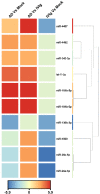IgG from Adult Atopic Dermatitis (AD) Patients Induces Nonatopic Neonatal Thymic Gamma-Delta T Cells (γδT) to Acquire IL-22/IL-17 Secretion Profile with Skin-Homing Properties and Epigenetic Implications Mediated by miRNA
- PMID: 35743310
- PMCID: PMC9224404
- DOI: 10.3390/ijms23126872
IgG from Adult Atopic Dermatitis (AD) Patients Induces Nonatopic Neonatal Thymic Gamma-Delta T Cells (γδT) to Acquire IL-22/IL-17 Secretion Profile with Skin-Homing Properties and Epigenetic Implications Mediated by miRNA
Abstract
γδT cells mature in the human thymus, and mainly produce IL-17A or IFN-γ, but can also produce IL-22 and modulate a variety of immune responses. Here, we aimed to evaluate whether IgG from AD patients (AD IgG) can functionally modulate thymic nonatopic γδT cells. Thymic tissues were obtained from 12 infants who had not had an atopic history. Thymocytes were cultured in mock condition, or in the presence of either AD IgG or therapeutic intravenous IgG (IVIg). Following these treatments, intracellular cytokine production, phenotype, and microRNA expression profiles were investigated. AD IgG could downregulate α4β7, upregulate CLA, and induce the production of IFN-γ, IL-17, and IL-22 in γδT cells. Although both AD IgG and IVIg could directly interact with γδT cell membranes, AD IgG could reduce γδT cell apoptosis. AD IgG could upregulate nine miRNAs compared to IVIg, and six when compared to the mock condition. In parallel, some miRNAs were downregulated. Target gene prediction and functional analysis indicated that some target genes were enriched in the negative regulation of cellular transcription. This study shows that AD IgG influences the production of IL-17 and IL-22 by intrathymic nonatopic γδT cells, and demonstrates epigenetic implications mediated by miRNAs.
Keywords: IL-17; IL-22; IgG; atopic dermatitis; human; miRNA; p-bodies; thymus; γδT cells.
Conflict of interest statement
The authors declare no conflict of interest.
Figures





Similar articles
-
IgG from Non-atopic Individuals Induces In Vitro IFN-γ and IL-10 Production by Human Intra-thymic γδT Cells: A Comparison with Atopic IgG and IVIg.Arch Immunol Ther Exp (Warsz). 2019 Aug;67(4):263-270. doi: 10.1007/s00005-019-00545-6. Epub 2019 May 13. Arch Immunol Ther Exp (Warsz). 2019. PMID: 31087106
-
IgG from Adult Atopic Dermatitis (AD) Patients Induces Thymic IL-22 Production and CLA Expression on CD4+ T Cells: Possible Epigenetic Implications Mediated by miRNA.Int J Mol Sci. 2022 Jun 20;23(12):6867. doi: 10.3390/ijms23126867. Int J Mol Sci. 2022. PMID: 35743308 Free PMC article.
-
IgG from atopic dermatitis patients induces IL-17 and IL-10 production in infant intrathymic TCD4 and TCD8 cells.Int J Dermatol. 2018 Apr;57(4):434-440. doi: 10.1111/ijd.13907. Epub 2018 Jan 22. Int J Dermatol. 2018. PMID: 29355930
-
Two functionally distinct subsets of IL-17 producing γδ T cells.Immunol Rev. 2020 Nov;298(1):10-24. doi: 10.1111/imr.12905. Epub 2020 Jul 22. Immunol Rev. 2020. PMID: 32700361 Review.
-
Gamma-delta (γδ) T cell-derived cytokines (IL-4, IL-17, IFN-γ and IL-10) and their possible implications for atopic dermatitis development.Int J Dermatol. 2023 Apr;62(4):443-448. doi: 10.1111/ijd.16364. Epub 2022 Jul 17. Int J Dermatol. 2023. PMID: 35844012 Review.
Cited by
-
Genomic, Epigenomic, Transcriptomic, Proteomic and Metabolomic Approaches in Atopic Dermatitis.Curr Issues Mol Biol. 2023 Jun 20;45(6):5215-5231. doi: 10.3390/cimb45060331. Curr Issues Mol Biol. 2023. PMID: 37367080 Free PMC article. Review.
-
Gender Differences in microRNA Expressions as Related to Long-Term Graft Function in Kidney Transplant Patients.Int J Mol Sci. 2022 Oct 24;23(21):12832. doi: 10.3390/ijms232112832. Int J Mol Sci. 2022. PMID: 36361623 Free PMC article.
-
IgG from patients with mild or severe COVID‑19 reduces the frequency and modulates the function of peripheral mucosal-associated invariant T cells in PBMCs from healthy individuals.Biomed Rep. 2023 Oct 16;19(6):95. doi: 10.3892/br.2023.1677. eCollection 2023 Dec. Biomed Rep. 2023. PMID: 37901873 Free PMC article.
-
Mechanism underlying polyvalent IgG-induced regulatory T cell activation and its clinical application: Anti-idiotypic regulatory T cell theory for immune tolerance.Front Immunol. 2023 Nov 29;14:1242860. doi: 10.3389/fimmu.2023.1242860. eCollection 2023. Front Immunol. 2023. PMID: 38094290 Free PMC article. Review.
-
IgG from Dermatophagoides pteronyssinus (Der p)-atopic individuals modulates non-atopic thymic B cell phenotype (alfa-4/beta-7) and cytokine production (IFN-γ, IL-9, and IL-10) with direct membrane interaction.Sci Rep. 2024 Mar 27;14(1):7274. doi: 10.1038/s41598-024-57950-x. Sci Rep. 2024. PMID: 38538762 Free PMC article.
References
MeSH terms
Substances
Grants and funding
LinkOut - more resources
Full Text Sources

